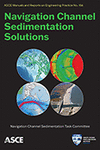ABS. See acoustic backscatter sensorABS-SSC correlations60Acoustic backscatter sensor (ABS)58, 60, 147Acoustic Doppler current profilers (ADCPs)60, 147Acoustic transducer system61Acronyms/abbreviations211–214Adams, Douglas52ADCPs. See acoustic Doppler current profilersAdvance maintenance dredging147Aggregation (flocculation)23–24Agitation dredging7, 44, 53, 147Airborne LiDAR Technical Center of Expertise62Aircraft LiDAR (light detection and ranging) scanning systems62Aleatory uncertainty in prediction methods95–96Alluvial sediments17–18ANN. See artificial neural networkAnthropogenic activities14, 147Antidune25, 147ArcGIS©10 toolbar77Artificial neural network (ANN)78Assessment of resources116–117Atchafalaya Bay channel (case study)196–199Athymetry61Atlantic Intracoastal Waterways31–32Avulsion (river)35, 147Bankline erosion38–39Bank Stability and Toe Erosion Model (BSTEM)73Baroclinic circulation13–15Barotropic flow13–14Barotropic processes14Base test/base condition147Base-to-plan test100, 135, 147Bed147density20shear velocity25Bedform25, 148Bedload measurement technology60, 148Bed material load25, 148Best practices for predicting channel sedimentation111–141agency modeling requirements140–141Bureau of Reclamation141Environmental Protection Agency140US Army Corps of Engineers140US Department of Interior141assessment of resources116–117conceptual site model114–115design approach115–116identify scale issues116information inventory113–114interpretation136–137management of numerical modeling studies137–140monitoring and feedback137numerical models application118–136boundary conditions121–122digital model mesh118–121fitness for use135–136initial sediment conditions122model dimensionality118–121model parameters128record keeping135sensitivity testing129–131spin-up simulation122–123testing133–135time-stepping of123–128validation131–133objectives statement112–113problem areas113problem definition112process boundaries delineation113reporting136–137tools selection117–118Better Assessment Science Integrating Point and Nonpoint Sources (BASINS)140Biotic activity26Bottom area/footprint method72Boundary conditions121–122Brier-Skill Score (BSS)97–99Brownian motion23, 148BSS. See Brier-Skill ScoreBSTEM. See Bank Stability and Toe Erosion ModelBuilding with nature (BwN)53Bureau of Reclamation141BwN. See building with natureBypassing (sediment)51, 148Calibration65, 148Cape Fear River (CFR, case study)184–186Case studies153–205Atchafalaya Bay channel196–199Cape Fear River (CFR)184–186Dogtooth bend reach, Mississippi river201–205Houston Ship Channel (HSC)164–166Long Island, New York, south shore channels187–190Lower Passaic River (LPR)160–163Mississippi River Ship Channel (MRSC)177–182Mouth of Columbia River (MCR)155–159New York/New Jersey Harbor (NYNJH)167–169Norfolk Harbor (NH)170–172Tennessee–Tombigbee (Tenn–Tom/TTW) Waterway191–194upper Mississippi river: Thebes, Illinois to Ohio river confluence173–176Cesium-137 (Cs137)63Channel deposition rate60Channel erosion rate60Channel sedimentation1–3, 145–146; See also navigation channels:alluvial/marine sources17–18definition1dynamics20–23mass exchange14navigation35–38off-channel38other factors26prediction methods for57–101problems3–6processes13–26properties19–20quality39scales18–19solutions and prediction history7–9sources17–18transport13–17vessel traffic effect on16Channel Shoaling Analysis Tool (CSAT)76Chromium-5163Coastal channel methods73–77Coastal Engineering Manual (USACE 2002)34Coastal navigation channel32–33Coastal sediment budget77Coastal Zone Management Reauthorization Act of 199042Coastline sedimentation processes34Cohesive sediments20, 23–24Cohesive sediment transport23–24Coldstart148Collision23Conceptual site model114–115, 148Coriolis effect14, 148CSAT. See Channel Shoaling Analysis ToolDean, Robert G.136Decision trees78, 207–210Deep-draft navigation channel31Density20Deposition rate60Design approach115–116Desktop methods66–78, 148bottom area/footprint method72coastal channel methods73–77inland channel methods73machine learning models78trapping efficiency66–71volume-of-cut method72Digital elevation models (DEM) store63Digital models148meshes88–90, 118–121of waterways87Dimensionality, model118–121Diversions43–44Dogtooth bend reach, Mississippi river (case study)201–205Dominant/driving forces13–17Draft4–5, 7, 16, 31, 148Draghead45, 149Dredging44–47Dredging records63Dual beam sonar62Dunes19, 25, 149Dynamic draft66, 149Ebb14Einstein, Hans26Engineering Research and Development Center (ERDC)140Engineering with nature (EWN)53Entrance Channel37Environmental justice53Environmental Protection Agency (EPA)140Envision53EPA. See Environmental Protection AgencyEpistemic uncertainty in prediction methods96Erosion16Erosion rate60Error in field observations65–66Estuarine navigation channel32–33Estuarine turbidity maxima (ETM)15ETM. See estuarine turbidity maximaEWN. See engineering with natureFederal Interagency Sedimentation Project (FISP)58–59Feedback137Field observations prediction method57–66deposition and erosion60dredging records63error in65–66hydrographic surveys61–63other data65sediment59–60sediment dating64sediment tracing64–65test pits63uncertainty in65–66Fines19–20Fine sediment (micrometer spatial scale) flocculation18–20FISP. See Federal Interagency Sedimentation ProjectFitness for use135–136Fixed-bed tracer models84Flocculated fine sediment19–20Flood14Fluid forces of barotropic flow13–14Fluid mud23Freshet15, 149Freshwater inflows14–16Froude number79–80Froude scaling79Fuzzy logic78Galveston Harbor Entrance84Generalized likelihood uncertainty estimation (GLUE) method100Geographic information systems (GIS)63, 149Geomorphologic2, 6, 19, 149Gilsonite84Graphical user interfaces (GUIs)93–94, 149Gravity13Grid. See meshesGUIs. See graphical user interfacesGulf Intracoastal Waterway31–32HEC-RAS modeling system73Heisenberg uncertainty principle132, 149Holism52–53Hotstart condition133, 149Houston Ship Channel (HSC, case study)164–166Hydraulic Modeling: Concepts and Practice, MOP 9783Hydrographic surveys61–63Hydrologic Engineering Center (HEC)140Hydrostatic88, 149Hysteresis15, 132, 149Icing of waterways16IHO. See International Hydrographic OrganizationInformation inventory113–114Initial sediment conditions122Inland channel methods73Inland navigation channel32–33Instantaneous sedimentation volume76International Hydrographic Organization (IHO)61International Organization for Standards (ISO)112Interpretation136–137ISO. See International Organization for StandardsISSDOTv2 method60Lacustrine79, 149Latin hypercube sampling100, 149Lead-210 (Pb210)63Lead modeler(s)138Lightering149Little, Charlie2Long Island, New York, south shore channels (case study)187–190Lower Passaic River (LPR, case study)17, 160–163Lutocline23, 44, 62, 150Management of numerical modeling studies137–140Marine sediments17–18Meshes88–90, 150Mississippi River Delta85Mississippi River Ship Channel (MRSC, case study)177–182Monitoring137Monte Carlo method100Motivation2Mouth of Columbia River (MCR, case study)155–159Movable-bed coastal models83–84Moveable-bed river models81–83Multibeam sonar62National Oceanic and Atmospheric Administration (NOAA)65Navigation channels2–3bankline erosion and38–39coastal32–33configuration and alignment33–34cross-section types33–34deep-draft31deposition rate60depth31erosion rate60inland32–33off-channel sedimentation38prediction methods for57–101reaches34sedimentation35–38, 145–146sediment quality and39shallow-draft31shoreline erosion and38–39in United States31–32Nephelometric Turbidity Unit (NTU)59, 150Newark Bay16–17New York/New Jersey Harbor (NYNJH, case study)167–169NOAA. See National Oceanic and Atmospheric AdministrationNoncohesive sedimentation20, 24–26dynamics24–26equations25–26processes25–26transportation process25–26Norfolk Harbor (NH, case study)170–172NTU. See Nephelometric Turbidity UnitNumerical modeling studies, management of137–140Numerical models85–94, 150application118–136boundary conditions121–122digital model mesh118–121fitness for use135–136initial sediment conditions122model dimensionality118–121model parameters128record keeping135sensitivity testing129–131spin-up simulation122–123testing133–135time-stepping of123–128validation131–133digital model meshes88–90digital models of waterways87dimensions87–88graphical user interfaces93–94programs86–87, 150programs capabilities90–93Objectives statement112–113Off-channel sedimentation38Overdepth dredging150, 192Parameters, model128Particle Reynolds number79PDF. See probability distribution functionPhysical models78–85, 150application examples84–85fixed-bed tracer models84movable-bed coastal models83–84moveable-bed river models81–83scales79–81Physicochemical processes150Plan test/plan condition150Porosity150Practical salinity units (psu)26Prediction methods57–101desktop methods66–78bottom area/footprint method72coastal channel methods73–77inland channel methods73machine learning models78trapping efficiency66–71volume-of-cut method72field observations57–66deposition and erosion60dredging records63error in65–66hydrographic surveys61–63other data65sediment59–60sediment dating64sediment tracing64–65test pits63uncertainty in65–66numerical methods85–94digital model meshes88–90digital models of waterways87dimensions87–88graphical user interfaces93–94programs86–87programs capabilities90–93physical models78–85application examples84–85fixed-bed tracer models84movable-bed coastal models83–84moveable-bed river models81–83scales79–81uncertainty in94–101aleatory95–96epistemic96with limited observed data99–100metrics from observed data97–99reducing100–101structural96Probability distribution function (PDF)99–100, 150Problem areas113Problem definition112Process boundaries delineation113Progress reports139Project manager138Propwash16Prototype78–85, 131–132, 150Purpose1QA/QC processes138–139Random variable100, 150Record keeping135Regional sediment management (RSM)52Reporting136–137Resources assessment116–117Reynolds number79–80Rheology150Ripple25, 150River flows15RMSE. See root mean square errorRoot mean square error (RMSE)97–99RSM. See regional sediment managementSalinity15, 26Sand wave150Scalesissues116physical models79–81Scandium-4663Scope1Sedimentation1–3navigation channels35–38off-channel38quality39rate74scales18–19solutions taxonomy41–42Sediment Budget Analysis System (SBAS) software for ArcGIS©10 toolbar77Sediment dating64Sediment deposition35Sediments59–60dynamics20–23mass exchange14particle settling velocity21properties19–20sources17–18suspension (erosion)24transport13–17, 20–21Sediment tracing64–65SED-PIT method75–76Self-weight consolidation26Sensitivity testing129–131Shallow-draft navigation channel31Shallow water waves22Shaw, George Bernard9Shoaling43–44, 76, 85, 117, 151Shoreline erosion38–39Single-beam surveys61–62Sinks17–18Skill Score98Smuts, J. C.52Social justice53Solutions to sedimentation problems41–53adaptation41–42, 47adapt to sediment regime47dredging44–47evolving environmental concerns47–49holism52–53keeping sediment in place42keeping sediment navigable44keeping sediment out43–44methods41–42prevention41–42sustainability49–50sustainability rating systems50–52taxonomy41–42treatment41–42SOW. See statement of workSpecific stage151Spin-up simulation122–123Squat31, 151SSC. See suspended sediment concentrationStandards for Hydrographic Surveys61Statement of work (SOW)138Static draft151Stochastic6, 100, 134–135, 151Structural uncertainty in prediction methods96Suspended load22, 24–25, 121, 151Suspended sediment concentration (SSC)59–60Sustainability49–50Sustainability rating systems50–52Taxonomy41–42, 145, 151Tennessee–Tombigbee (Tenn–Tom) Waterway32–33, 191–194Testing133–135Test pits63Thalweg32, 35–37, 85, 151Thomas, W. A. (Tony)136Tidal asymmetries and lag effects14Tidal currents14Tidal distortion14Time-stepping123–128Time-stepping of numerical models123–128Tools selection117–118Total hydraulic volume exchange per tidal cycle74Total load151Total suspended solids (TSS)59–60Transport13–14Trapped sediment amount66–69Trapping efficiency66–71Trim31, 151TSS. See total suspended solidsTurbidity59–60UKC (Underkeel Clearance)31, 151Uncertainty in field observations65–66Uncertainty in prediction methods94–101aleatory95–96epistemic96with limited observed data99–100metrics from observed data97–99reducing100–101structural96Upper Mississippi river: Thebes, Illinois to Ohio river confluence (case study)173–176USACE. See US Army Corps of EngineersUSACE CSAT computer program63USACE Smart Planning117US Army Corps of Engineers (USACE)43, 63, 140US Department of Interior141Validation95–99, 114–115, 117, 123, 131–133, 151Validation-derived uncertainty98–99Van der Waals forces23, 151Velocityof bed sediments25of cohesive sediments23Verification95, 132, 151Vessel traffic16Volume-of-cut method72Wall Reynolds number79Wash load25, 111, 121, 151Water quality26Waterways, digital models of87Wave models81Waves14, 16, 22–23Weber number79Wind energy13Wind-waves16Winnowing26